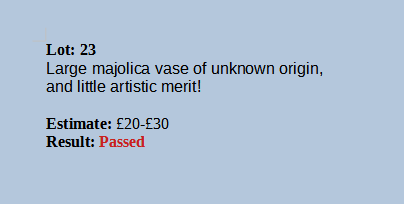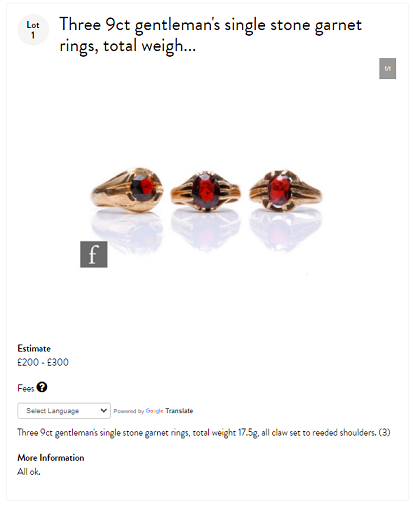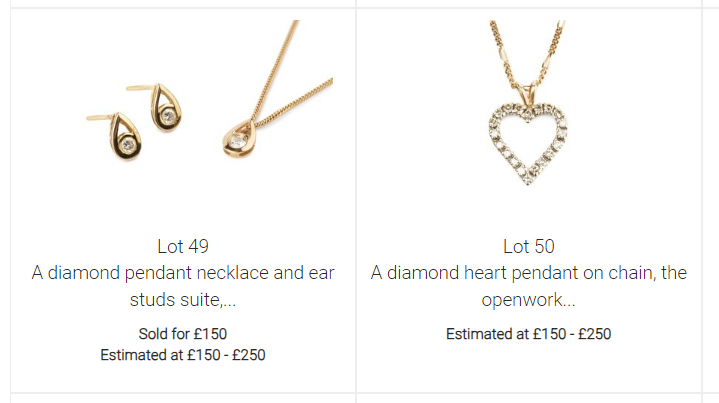Have you ever wondered what if no one bids on an auction lot? If you’ve ever watched an auction you’ll probably have heard the auctioneer say something like “I’ll have to pass that one”. This is the tumbleweed moment, when bidding ends on a lot without it selling. This of course, is generally bad news for all concerned.

A typical, but entirely fictional, auction lot listing, indicating how a passed lot might be shown in the auction results.
Having to pass a lot can happen for a number of reasons. In this post, I’ll explain what happens next, but first it’s worth understanding how we get to this point. This is especially important if you’re thinking of trying to sell items through an auction.
Reserve prices
Some auction houses will place a “reserve” price on almost all items being listed for sale. This is generally when the auctioneer is dealing with items that all have a reasonable value. In the UK at the time of writing that’s probably around at least £50. The reserve is the minimum that the auctioneer will sell the item for. The reserve is never made public as it may skew the bidding, but you can generally be sure that if an estimate is published, the low end of the estimate is at or just above the reserve.

A recent listing from a Fieldings auction catalog. No reserve price is given, but you can be sure that the rings won’t sell for less than about 90% of the lower estimate, in this case about £180.
Not all auction houses assign a reserve to every lot. If you’re not happy for an item of yours to sell for less than a particular amount, make certain the auctioneer knows this at the time your item is accepted for sale. If you don’t and it sells below your minimum target value, it’s too late to complain afterwards.
Setting a reserve can be a difficult thing. I suspect that it can be one of the harder parts of being an auctioneer. For the vendor, an item being sold may come with some emotional attachment (even though it’s being put up for sale) which affects their judgement of it’s value. The vendor will almost certainly have had a look on the Internet to get a guide for a similar item’s resale or retail value. The vendor may even know what an item cost when it was purchased. There is also something of a mistaken belief that old things are always better quality and that they magically accrue value just because of their age. This is sometimes true but you shouldn’t assume it.
All of these things can conspire to lead the vendor to expect a somewhat higher estimate than the auctioneer arrives at when they look at the item. The auctioneer’s judgement is usually simply based on what they think their buyers might be prepared to pay for it. If you’re the vendor, if the suggested reserve is too low for you, remember you don’t have to sell through that auction house. If multiple auctioneers give you similar estimates, you probably need to take the hint, however painful it might be.
As a backstop, albeit not a reliable one, a good auctioneer should know when an item is way below a sensible bid level. If the bidding stops well short then they may pass the lot unless the vendor has specifically said to sell at whatever is bid.
Minimum bids
With an understanding of the reserve price, it’s easy to see how an item might go unsold. However even without a reserve some items will still get passed. Quite simply, some items might not attract a bid at all, especially when the auction house has a minimum bid level.
One of my local auction houses, Littleton Auctions has a pretty strict £10 minimum bid. As a vendor, you really don’t want items to be selling at that price. With fees and costs you only get about £3 back! Those costs are common to all auction houses and Littleton Auctions state that they aim for every lot to have a value of at least £30, so generally speaking it’s quite rare for items to pass without a bid.
I think the only time I’ve seen Littleton Auctions break their £10 minimum rule was during the filming of the BBC television program Antiques Roadtrip. On that occasion one of the items provided for sale by a competitor failed to attract a bid and the auctioneer, Martin Homer, dropped the bid to £5 with an accompanying plea to the room of “Help!”. Someone kindly stepped up and bid. I wonder if Martin has nightmares about that one? I hope not, it wasn’t his fault and he managed to make an excellent comedy moment out of it.
Getting bidding above the reserve
Watch any auction and you’ll see how the auctioneer often starts higher than anyone will begin to bid and the bidding only kicks in once the offered price has dropped. Of course the auctioneer will want to keep the bidding above any reserve price but that’s not always possible. Sometimes to flush potential bidders out, the offered price has to drop below the reserve in the hope that the bidding competition will bring the price back up. Most times this works, but not always.
If the bidding never starts or stops below the reserve price then the auctioneer has no option but to pass the lot. This can be really frustrating for the highest bidder at that moment, especially if they were prepared to go higher but had no one to bid against. Where the bidder is in the room, an experienced auctioneer will occasionally invent a Phantom bid. This is where the auctioneer pretends the active bidder has someone to bid against them. In a busy auction room this is quite easy to do but is usually considered unfair (even unethical) as it forces the bidding level up and the buyer ends up paying more than they would have. However where it’s only used to get a sole bidder above the reserve price then I think it’s probably reasonable.
Post auction offers
At the end of bidding if an item is passed, it remains unsold. However that might not be the end of the story. If you see an item passed and you suddenly think you’d have liked to bid on it, all may not be lost. Get in touch with the auction house soon after the auction has finished. They will almost always be delighted to sell you the item at the reserve price or, for unreserved items, the last bid value that was offered. Don’t try to be unfair by offering a much lower amount, the auctioneer won’t sell and you’ll just cause upset. Offer a reasonable amount and you’ll be popular with everyone and generally you’ll get an absolute bargain for your trouble.

Two items from the sale results at Mallams Auctioneers. The lot on the left sold at the minimum estimate, but notice the lot on the right has no “Sold for” price. A quick call after the sale might have secured the pendant for at most £150, possibly a little less.
If at first you don’t succeed… you might like to try again
If an item remains unsold with no post-auction offers, it has to go back to the vendor. If that’s you, expect to be asked to collect the item within a couple of days of the auction since auction houses never have enough storage space for the items they get left with. There will usually be a small charge from the failed sale but it’s not usually very much. For higher value items auctioneers will usually be happy to discuss relisting the item at a future auction, possibly with a lower reserve. It’s up to the vendor to decide if they want to have another go. If you find yourself in this position don’t be too disheartened. I’ve often seen items passed at one auction, get relisted next time and be sold for a good price. Not everyone can get to every auction and if an item is of value it will sell eventually.